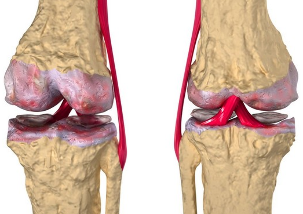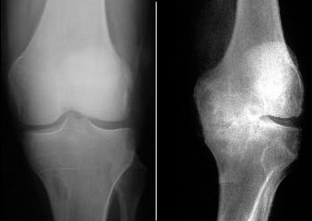All synovial joints affected degenerative-dystrophic diseases – arthritis, but some more, some less. Most often affects the osteoarthritis of the knee and hip joints because they are exposed to significant loads, and knee joints – and even injury. If the arthritis is localized the knees, diagnosed gonarthrosis (osteoarthritis deformans of the knee joint). Knee osteoarthritis – a disease that often leads to temporary disability and disability. What is osteoarthritis of the knee joint, for some reason develops and how this is manifested the disease, how to treat it – the topic of this article.

A bit of terminology
Osteoarthritis – non-inflammatory articular disease that starts with degenerative processes in the articular cartilage, then the process involves the articular area mating bone, synovium, muscles that support the joint. Another name of this disease is osteoarthritis, it indicates that the pathological processes occurring in bone tissue.
To Refine the localization of the disease name add name on: osteoarthritis of knee, osteoarthritis of the ankle. Because at a late stage of the regional expansion of the articular sites lead to severe deformation of the body, osteoarthritis of the knee joint and other articular joints is called deforming, abbreviated as DOA. The diagnosis of DOA means the same as osteoarthritis.
What is osteoarthritis and what else they called him? Quite often in the Internet you can find the phrase gonarthrosis of the knee, osteoarthritis of the hip joint. If the first definition is a tautology, the second is a mixture of the names of two different joint diseases. The fact that for convenience, denote the most common types of arthritis use of the name, which refers to localization. So, the first part of a compound word "gonarthrosis" dates back to the ancient Greek word meaning "knee". That is, the gonarthrosis is osteoarthritis of the knee, can also be used as the name DOA of the knee joint, knee osteoarthritis. But the names of gonarthrosis of the knee joint and the like are redundant.
Knee anatomy
In the literature it is also possible to find references about osteoarthritis femoro-patellar joint or patellofemoral syndrome. To understand what it is, you need to get acquainted with the anatomy of the knee joint. This is a condylar joint:
- the articular surface of the femur is a convex head;
- the tibia is hollow.
In addition to the major bones in the formation of the knee joint takes part a small sesamoid bone known as the kneecap or patella. The rear surface of its upper edge articulates with the femur. Patella in Latin is called the patella and the femoral bone – femara. That is, if translated into Russian word femoropatellar, you get a femoro-patellar. This is not a standalone joint, and an integral part of the complex knee joint. Holds the patella in the correct position, the ligaments, but sometimes it moves due to injury or initially has the configuration, leading to instability.
Displacement, instability of the patella – the main factors leading to the development of the so-called patellofemoral osteoarthritis. The causes also include traumatic damage to the cartilage of the patella at blows, falling. Experts usually use the term patellofemoral pain syndrome, as the mechanism of development and clinical picture of this pathology is different from the classical, typical for osteoarthritis. The disease is treatable, because the thinning of the cartilage (chondromalacia a) there is only 3 stages, the prognosis is quite favorable. But in the absence of proper treatment, the disease goes into gonarthrosis.
The causes of the disease
What is osteoarthritis of the knee and what causes it cause? One we have already mentioned – injury and instability of the patella, running patellofemoral syndrome (physicians often view it as pietros).
The causes of osteoarthritis of the knee include:
- congenital weakness of muscle and ligament that stabilizes the knee joint;
- vascular disease of the lower extremities (varicose veins, thrombophlebitis), which disturbed blood supply to the knee;
- protracted inflammatory processes in the joint cavity and periarticular tissues;
- endocrine diseases, especially diabetes;
- injuries of the lower extremities.
Arthrosis of the knee, threatens people diagnosed with DOA ankle, the hip, flat feet. With the defeat of the ankle or hip joints, the violation of the support function of the foot increases the load on the knees. With age, the incidence of arthrosis of the knee joints increases. This is due to the slowing of metabolic processes and regeneration processes and blood circulation disorders, natural wear of cartilage, changes in hormonal levels.
Gonarthrosis at a young age often develops in persons with genetic predisposition, genetic defects of connective tissue. He is also prone to athletes and people engaged in heavy physical work load on the legs. Very harmful knee joints weight.
Symptoms

If you have arthritis of any localization symptoms gradually increase from stage to stage. 1 stages of osteoarthritis, the patient experiences discomfort:
- legs get tired quickly;
- in the beginning of the movement there is a short pain, feeling of tightness, stiffness, but about half an hour these symptoms disappear;
- the pain can be resumed after a long load, but disappears after rest.
2 stage small enough load to cause pain and require a longer stay, so she passed. Since this stage is often inflamed synovium to mechanical joining of inflammatory pain that occur at rest. For synovitis characterized by the increase of the knee due to accumulation of inflammatory effusion in the joint cavity, the skin often become red, hot to the touch.
If early contractures (limitation of joint mobility) are mainly related to pain during movement, according as the disease progresses, knee articulation, contractures become resistant. Grow osteophytes that prevent the movements become shorter and lose their elasticity of the ligaments, weakened muscles, reduced production of intra-articular lubricant – synovial fluid. 3 stage range of motion is greatly reduced, some patients can only perform rocking motion in the knee. Finally, at a later stage the joint is deformed due to bone growths, leg bent at the knee (X-shaped or O-shaped deformation).
What is osteoarthritis of the knee and what symptoms to distinguish it from patellofemoral syndrome? For the last characteristic:
- pain that is localized in the anterior aspect of the knee, usually felt when Jogging, they get stronger during squats, lifting from the chair, walking the stairs;
- swelling in the region of the patella;
- hobbling gait;
- clicks during movement, and clicks and pain do not occur simultaneously.
Swelling of the knee, gait changes, pain is characteristic of osteoarthritis, but the pain is felt deep in the joint, often suffers from its inner side. Movement often accompanied by pain and crepitus. To accurately determine the localization of the process, the necessary functional tests and x-rays.
Diagnostic methods
The diagnosis of DOA is made after a comprehensive examination of the patient. First, the doctor listens to complaints, is studying the history, examines feet, palpated joints, performs passive movements and asks the patient to perform active range. Gonarthrosis is unilateral and bilateral. In unilateral lesions the healthy limb compared to patient. Assess range of motion, muscle strength, measure the girth of the thighs and shins, feet length. Because the osteoarthritis is accompanied by atrophy of the muscles and ligaments affected leg is reduced in volume and shortened.
After physical examination and laboratory assign hardware:
- the main method of diagnosing osteoarthritis – x-ray, the picture is taken at least 2 projections;
- CT scan – a type of x-ray examination, during which gives a layered image of a joint;
- assess the condition of the cartilage, soft tissue, the volume of synovial fluid allows ultrasound;
- a highly informative method of diagnosis – MRI;
- the tests are assigned to distinguish osteoarthritis from arthritis and other inflammatory diseases.
In the diagnosis and determining the extent of osteoarthritis in knee joints based on x-ray data.
- Minor, usually irregular narrowing of the joint space, osteophytes initial in the form of small cusps on the edges of the articular sites.
- The articular narrowing of the lumen of 50% or more, multiple large osteophytes, compaction of bone tissue (osteosclerosis) in the places of greatest load. On the background of foci of osteosclerosis may be observed of the enlightenment – testopodobnymi cavity.
- The almost complete absence of the articular gap, pronounced osteosclerosis, coarse osteophytes, deformation of the articular surfaces of bones, smoothing of their relief, the curvature of the axis of the limb.
Treatment
Next question: what is arthrosis of the knee and how to deal with it? Treatment for this disease is diverse, it is extremely important integrated approach, a combination of drug and non-drug therapy. Treatment should start with limiting the load on the knees. It is necessary to refuse from running, jumping, lifting, patients who are overweight should lose weight.
Those whose muscles are weakened due to a sedentary lifestyle, you need to move more, but not to overload the knee. Shoes should be comfortable, when walking it is recommended to use a cane, also an orthopedist can pick up the knee, orthosis and other devices for unloading and stabilization of the joint. Definitely need to stick to a diet.
Medication

How to treat arthritis if it is accompanied by pain? Most often they are cropped using non-steroidal anti-inflammatory drugs that are given orally and used in the form of ointments, gels. Additionally prescribe irritating ointment. During intense inflammatory process can be shown injection into the joint of hormonal drugs in combination with local anesthetics. But this treatment only relieves the symptoms, it is conducted short courses, according to testimony.
At the 1-2 stages of symptomatic treatment necessarily must be combined with long-term administration of chondroprotectors. These drugs slow the breakdown of cartilage, and at an early stage even contribute to its recovery. Perfectly relieve pain and restore mobility intra-articular injections of hyaluronic acid.
Of drugs in osteoarthritis may also be administered vasodilators and drugs to improve microcirculation, and it is shown in circulatory disorders of the joint. To relieve muscle spasms help muscle relaxants. A specific tool for the treatment of arthritis along with cartilage protectors is the drug that neutralizes the activity of a protein that destroys cartilage.
Non-drug treatment
Indicated for osteoarthritis of the knee and non-drug treatment. The methods of non-pharmacological treatments include:
- physiotherapy electrophoresis, ultrasound, magnetic therapy, laser therapy, shock wave therapy, ultraviolet irradiation, and others;
- application of paraffin, ozokerite;
- compresses with Dimexidum, medical bile, bischofite;
- massage with the influence not primarily on the joint itself and its surrounding muscles;
- manual therapy – stretching or mild reduction of the joint;
- Physical therapy, therapeutic gymnastics. To master the exercises in this training video, descriptions of complexes with a photo, but it is better to start exercising under the supervision of an instructor.
In some clinics tested an innovative method of treatment – stem cell therapy. It allows you to restore cartilage tissue without resorting to surgery.
1 stage of gonarthrosis shown only conservative treatment, starting with 2 may be performed surgery. Most advanced surgery for osteoarthritis:
- arthroscopic of debridment – removal of osteophytes and necrotic areas of cartilage through a small incision;
- arthroscopic chondroplasty – fix articular cartilage;
- arthroplasty – joint replacement artificial.
The first two operations are usually carried out in 2 stages, give temporary effect for 1-2 years. The endoprosthesis shown in 3 stages of osteoarthritis of the knee, is the only way to avoid disability. Implants only last 15-20 years before requiring re-operation.
Gonarthrosis or arthrosis of knee joints is among the three most common types of arthritis. Knee pain can point not only to the development of osteoarthritis, but the damage to the ligaments or meniscus, arthritis and several other diseases. Therefore, the appearance of anxiety symptoms you need to consult a doctor and get tested.
Often osteoarthritis of the knee progresses slowly from the first symptoms to total loss of function of a joint can take a couple of decades. Completely cure gonarthrosis impossible, but if you start treatment at an early stage is more likely to slow down its development and delay the last stage, leading to disability.



































